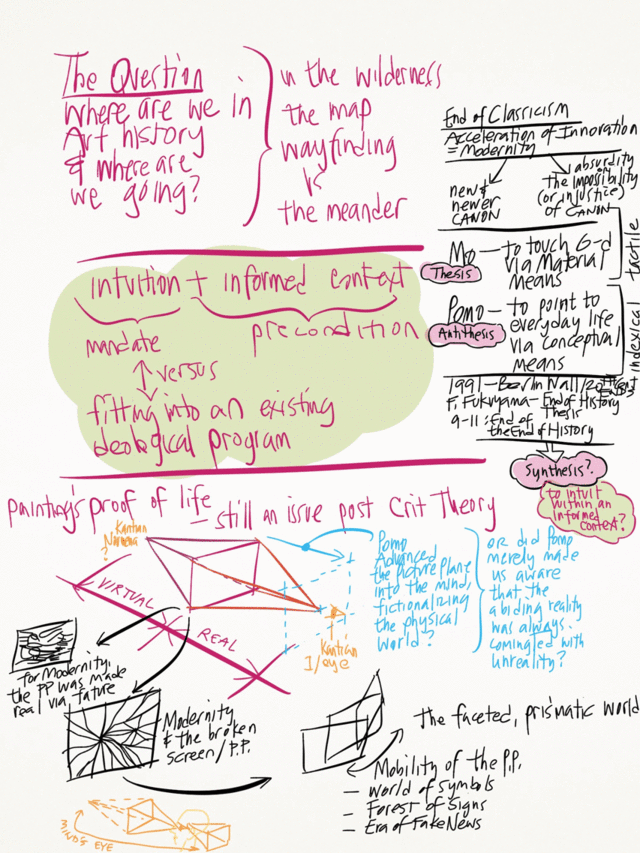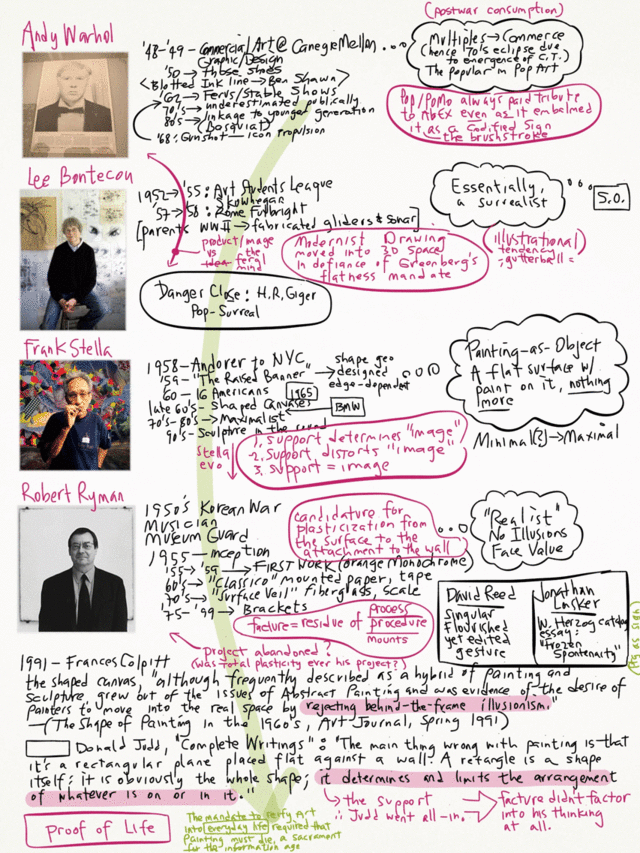December 20, 2018
Thinking Aloud

This post offers no conclusions, just a few tugs on some tendons in history.
Painting with a catalog of formal attributes of impasto oil (in addition to the usual characteristics of paint: color, tone, etc)... it was like I found a hidden pull down menu in painting's program. I was looking for the PROOF OF LIFE after being force fed the narrative of the so called "death of painting" via critical theory in grad school.
Paint rose from the muck, like Neo wriggling out of the pod in Matrix. Like Laocoön and the Hellenistic Baroque group, entanglement is the prime attribute of facture. (Facture is a characteristic quality of paint handling. All paint is handled. Some like to think of Rothko. Like Van Gogh, I tend to think of Franz Hals, Velasquez and Goya.)
I started with Warhol because I wanted a foil for the artists to follow, and probably because I had just seen the Warhol show at the Whitney, Andy Warhol--
From A to B and
Back Again. As the title suggests, Warhol completed a circuit in his life. What is A? What is B? A recent conversation with friend S.O., we talked about how -when- art reaches the stalemate of Classical epitome, the only way forward is a disruptive baroque. We agreed that Warhol returned to the AbEx he departed from in his final paintings, especially his paintings hung in the last room of the Whitney exhibition... a huge horizontal of thirty feet or more... that made me think of David Reed's controlled and cropped brushy flourishes. Was -is- Reed doing what DeKooning would have done if he had lived another 20 years and not had lost his mind? And remember, Willem blotted his paint, not unlike Andy did his inky lines.
Jumping to the front of the line, it was Robert Ryman who declared the totality of a painting from all elements of the support through the paint to the varnished cap, to be candidate for plastic manipulation. Facture. Curious -to my mind- that he seemed to have abandoned this project, I see no signs of this radicalized plastica in his recent work... or perhaps I misunderstand him? No matter, I like the portrait just as I have drawn. It was the need for armature that brought me to the vitrines. It was the inherent limitations of impasto oil that keeps my scale to the size of arms embraced. Any larger, and material strains under the extremes of physics, such as the extents of flying saurischians or lumbering brachiosaurs as the brontosaurus did. Galileo's Square-Cube Law applies to paint as well. So it was that the armature of my vitrines prompted me to think of the support-as-armature and this train of thought brought me to Ryman.
S.O.'s comment about the baroque escape from the straight jacket of refinement, brings us to Stella. His painting as an object "...a flat surface with paint on it, nothing more..." conjures Judd's position that the rectangular plane of painting "...determines and limits the arrangement of whatever is on or in it." Of course, Judd isn't conceding that limits can also summon limitlessness... every argument involves artifice, after all. But Stella's early painting is an elegant exercise of the Judd position. I wonder how much they communed in thought together?
It was in the constructive plastic potential of the support that I saw relatively unexploited, opportunities yet to be explored. The likes of Supports/Surfaces Group are not included in my list since approaches like that assume that the configuration of the traditional canvas & stretchers is a given, and all that can be done is to attenuate them. There is much more possible when an architect's eye looks at the tension and compression, the nature of wood, wire and weave of canvas.
Page two.
When I was teaching architecture design back in the 90's, I asked my students to define modernism and postmodernism when I realized that they were trading in terms that they didn't yet clearly understand. I was surprised to learn Shortly thereafter that many (if not all?) in my community in the art world found it difficult to supply succinct definitions of the operative programs of the 20th century. In fact, there seemed to be an unwillingness to summarize the latter or even trade in the use of the term, succinctness was too essentialist then... and perhaps this sentiment yet lingers today. Naturally, I was asking a question I was more than prepared to answer. To be modern is to touch G-d (better, to attempt to touch G-d) via material means. To be postmodern is to point (indexically) to everyday life (the quotidian)via conceptual means.
Now, I have another question pertinent to our time... at a point in our history when we find it difficult to gaze squarely at history both past and to come. This is a question that I've started to ask of my fellow artists, but also upon the recent occasion of visiting the studios of a local art graduate school: where are we in art history and where are we going? Much like my interrogatory of the 90's, this one of the latter aughts (just curious, what will the generation coming of age in 2020 be called?) stirs not an insignificant amount of anxiety. Well. good. We should be uneasy when we avoid confronting the obvious.
I'm encouraged to find stirrings of unease in articles such as this: Looking Back to Move ForwardWhen I try to make sense of art today, it feels similar to the 1970s--a period during which the rule book was thrown out, and artists splintered into byways of plurality. Then as now, it was unclear where art was going. Looking back with the benefit of hindsight, we can now recognize the 1970s as one of the most exciting and epoch-transforming decades in the history of modern culture. But then, that was a daring, liberating and revolutionary time for art while today feels rife with careerism, stylistic conservatism, and sophomoric (or base) chess moves.
We should have asked such questions thirty years ago when the fall of the Berlin Wall signaled the end of the 20th century (a decade early), and 17 years ago when the end of the End of History prompted us fruitlessly. Is it any wonder that zombies walk amongst us?
Almost as a footnote, I jotted another thought stream about the operation of the picture plane in the context of all the above. Half digested, there is something important here.
All of this analysis is in service to intuition. In contrast to the programmatic diktat of the era of Critical Theory, the successor epoch will be driven by its' antithesis, by gut instinct and inkling. Whispers to G-d's ear perhaps? Perhaps. But intuition operates in a context that is perceived perhaps consciously and certainly at levels of awareness that exist just below the surface. Like quality compost, diversity and aeration are key elements of a healthy civilizational seedbed.
Posted by Dennis at December 20, 2018 10:38 PM
Leave a comment